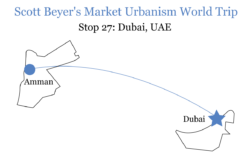Is Dubai a YIMBY Success Story?
The wealthy emirate builds a lot, but is not a free housing market - and falls short of what it needs.
The emirate of Dubai is renowned for rapid urban growth. Staying there for two weeks during my 1.5-year Global South tour was inspiring; nowhere in the Western Hemisphere prepared me for the sheer volume of skyscrapers, highways, planned communities and other massive infrastructure getting built. It made me wonder whether Dubai’s rapid construction had turned it into another YIMBY success story. The answer’s complicated.
Dubai, for starters, is adding residents rapidly thanks to the United Arab Emirates’ pro-immigration policies, which we covered last week. Between 2010 and 2020 its population grew by 53%–over 1 million people total (metro New York City grew just over 2% in the same period). The question is whether Dubai’s housing construction is keeping pace with this extreme population increase.
High housing unit growth is, as I’ve noted repeatedly in this column, consistent with lower prices, moderating the effects of such rapid population growth. U.S. Census permitting data tells a consistent story: metros that allow high annual per-capita new unit counts, such as Houston and Dallas, are cheaper than those that restrict housing, such as New York, Los Angeles, and San Francisco. The “YIMBY” moniker (Yes in My Back Yard) has inspired a movement that calls for liberalized zoning in those latter metros. Along with Texas, YIMBYs point to foreign examples such as Tokyo as pro-housing success stories. Should Dubai be added to the list?

Statista reports that Dubai added about 38,000 units annually the last few years. That would give it a construction rate near the top of U.S. metros – in fact, above recent Houston and Dallas rates.
However, looking at extant units, there were 723,000 total housing units in the emirate in 2022. That’s 0.22 units per capita out of a population of over 3 million, lower than both construction-friendly Texas and even hyper-NIMBY California. For all the construction that’s occurring, it doesn’t keep up with the breakneck inflow of people from Europe, Africa and elsewhere in Asia.
This means Dubai isn’t particularly affordable. Average apartment rents are around $2,268 per month. Some residents spend more than half of their income on housing, and immigrants that I’ve spoken with describe the cramped conditions some of their peers live through in labor camps, with 5 people or more to a room.
Rents are also going up; CNBC reports that they had increased as much as 60% from the previous year. This is expected to continue as people continue flocking in.
Still though, Dubai is cheaper than what one might say are its peer U.S. cities. Average rents in San Francisco are $3,313 and $3,660 in New York City. Reuters notes that Dubai has “an ample supply of homes to live in” compared to other high-demand markets.
So is Dubai a case study of a megacity that, like Tokyo, allows free markets in housing to meet demand? Despite all its new construction, not really.
On one hand, some controls are theoretically lax. Dubai ranks among the easiest places to get a permit; the process typically only takes five days thanks to a 2017 reform. In the U.S. it can take years. And according to University of Chicago researcher Beau Shaw, Dubai does not have the same community input process that slows housing construction in many Western markets-after all, it’s a monarchy.
But the royal family’s control over large land swaths means there is a natural incentive to limit the land available for development.
“The U.A.E. treats real property and real estate development rights as gifts for allies and friends of the ruling families,” Shaw writes. The development market isn’t competitive, made up of large, politically connected conglomerates (some being directly owned by Dubai’s government or former officials who maintain close ties) “who build exclusively megaprojects.”
Analysts have noted that the emirate’s housing pipeline falls short of demand. This will likely worsen in coming years, as Dubai is projected to have 7.8 million people by 2040, adding more than 2 million people per decade–a figure no U.S. metro will likely approach.
The emirate is also not immune to some of the destructive housing trends coming from the West. There is a rent control policy wherein rents for occupied apartments are capped, but rates for vacant apartments are uncapped. It has design and engineering laws that help explain why so many buildings look similar and are built to such an expensive standard. The city’s 2040 Master Plan includes objectives that will sound familiar to U.S. urbanists, such as a goal to “plan vibrant and healthy communities with a range of housing and core facilities,” indicating that its planners seek to proscribe uses.
In sum, Dubai’s building a lot. But housing markets are complicated, and “a lot” does not automatically mean “enough”. Prices remain high there due to some combo of rapid population growth that private developers can’t keep up with; an unwillingness for said developers to build for lower-income groups when there are higher-end clients to chase; and codified building standards that make deeply affordable housing impossible. But autocratic rule–backed by the monarchy’s ownership and cartelization of many land-use aspects–is the main cause of high prices. It’s what prevents Dubai from achieving true YIMBYism.
Graphic Credit: The Market Urbanist.
Catalyst articles by Scott Beyer | Full Biography and Publications
